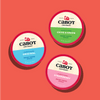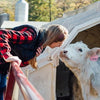
Grate Questions: What Is Aged Cheese?
Aged cheese has long held a special place in the hearts and taste buds of food enthusiasts and throughout the culinary world. The rich umami flavors and firmer texture developed over weeks or even years of curing make aged cheeses stand out from the milder taste and softness of the fresh varieties.
The World of Aged Cheese
All cheeses are made from milk, salt, enzymes, and bacterial culture, but it's the aging process that gives each kind its unique flavor profile. Aged cheese is essentially cheese that is left to cure for an extended period of weeks, months, or years so that it becomes more flavorful. This process is known as affinage.

The cheesemaking process begins by separating the curds from the whey and then shaping them. Fresh cheeses are ready to eat directly after this step. They typically have a soft texture which makes them excellent choices for melting. Most are white in color and rindless.
Aged cheeses require more time to prepare. They get placed in a controlled environment to mature and develop rich, concentrated, and complex umami flavors with varying levels of sharpness, nuttiness, and creaminess. Depending on the desired result, the aging process may involve:
- Surface-ripening washes or brines to age from the surface down. This method develops rinds on the cheese.
- Interior ripening is the opposite as the cheese ripens from the inside by wrapping the exterior in cloth to prevent a rind from forming.
The temperature and humidity of the environment play a big role as they influence how quickly the cheese loses moisture. Aged cheeses develop their compact and hard texture due to the moisture loss the young cheese experiences during the aging process.
Another difference between fresh and aged cheese is the amount of lactose present in the finished product. Since lactose breaks down during the aging process, aged cheeses are easier for many people to digest. Some top examples of aged cheese include:
Cabot Creamery employs cheese graders to ensure we continue to provide our customers with award-winning quality. Our team has perfected the unique blend of art and science required for cheese grading. We age our cheeses in 42-degree storage facilities, where each one is tested for taste, texture, smell, and quality by removing core samples with metal triers.

The cheese graders keep extensive records to determine which cheeses are aged into which varieties. The sharpness of the finished cheese depends on the length of the aging process.
The Impact of Aging on Sharpness
Cheddar cheese tastes amazing. It's great for snacking, for melting into soups and dips, and for incorporating into your favorite recipes. However, the length of aging affects the cheddar cheese sharpness scale.
Young cheeses start out smooth and creamy. As they lose moisture during the aging process, the texture firms and the cheese forms hard crystals of calcium lactate as the lactose breaks down.
The sharpness of a cheese refers to the changes that happen to its taste and texture as it ages. Most cheddars age from two months to one year, with sharpness increasing the longer the cheese matures. The final taste ranges from mild cheddars with a mellow, buttery flavor to seriously sharp varieties with a complex flavor and crumbly texture.

Pairing Aged Cheeses & Recipes
Cheese is the ideal accompaniment to fruits, meats, and other delicious morsels. Learn how to pair aged cheeses to give your guests something to rave about at your next event. Check out these cheese pairing guides for inspiration:
- Apple and cheese pairings
- Charcuterie and cheese pairings
- Pear and cheese pairings
- Herb and cheese pairings
The key to a good cheese pairing is to understand what enhances the flavor. Check out our cheese pairing guide along with our multitude of cheese pairing recipes to discover what you like the best.
If you want to incorporate delicious aged cheddar into your dishes check out some of our popular recipes like Cheddar Basil Prosciutto and Melon appetizer or try making a Gourmet Cheese board.
Practical Tips on Storage
Most types of aged cheeses last longer than non-aged cheese due to the lower moisture content. However, proper storage is crucial for food safety and to preserve quality and taste. Follow these suggestions to maximize the enjoyment of your favorite aged cheeses.
Keep all cheeses wrapped up and stored in the refrigerator to extend their shelf life. Harder aged cheese can be left out of the fridge for up to four hours depending on its firmness, but you should check the cheese for any indications it has spoiled and discard it if you have any doubts.
Opt for wrappings that allow the cheese to breathe to prevent bacteria growth. Instead of plastic wrap, use butcher paper, parchment paper, or cheesecloth. Bee's wrap is another superb choice. It's a natural packaging material made from beeswax, cotton, and tree resin. Cabot Creamery offers a range of accessories that include reusable cheese storage options like the Cabot Cheese Vault and Formaticum Cheese Bags to keep your cheese fresh.
Learn More with Cabot Creamery
Aged cheeses are cheese varieties left to mature over time in a temperature-controlled environment. As the cheese ages, it loses moisture and gains a firmer texture, while developing a more complex and deeper flavor profile.
Aged cheese is delicious on its own and also shines as the star ingredient in many favorite recipes. Browse our recipe collection to discover new ideas to add to your dinner rotation or check out our cheese sharpness bundle if you’re in the gifting spirit. Whether you plan to host a family meal or a party for your friends, wow everyone's palate by selecting the best quality cheeses for your dishes, dips, and appetizers. Shop Cabot Creamery's array of cheeses to enjoy exceptional quality and flavor!

















